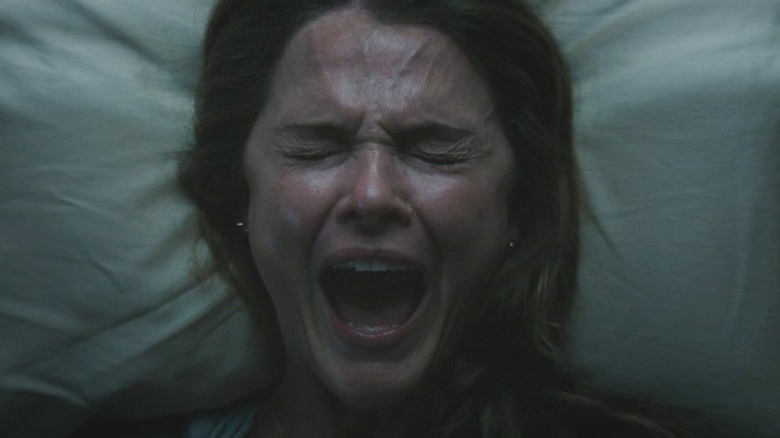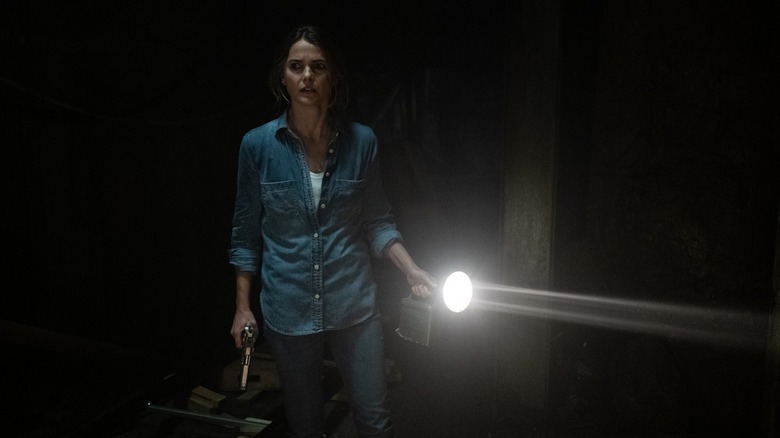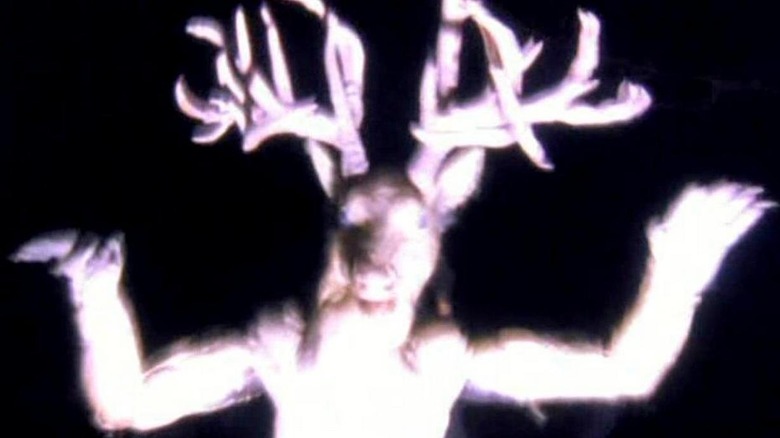Why The Wendigo Means More Than You Think In Antlers - Exclusive
"Antlers," the new horror movie from director Scott Cooper ("Hostiles") and producer Guillermo Del Toro, is based around a monster from Native American folklore that has haunted a number of horror stories in the past: the wendigo.
According to the book "The Windigo in the Material World" by Robert A. Brightman, the wendigo (the spelling is largely interchangeable) was a malevolent entity of First Nations folklore, mostly specific to Algonquian-language cultures of Canada and the upper United States. Originally described as a giant, emaciated, nearly skeletal being with ashen flesh — almost a walking human corpse — and said to smell of rot, decomposition and corruption, the spirit has been portrayed in more recent times as a monstrous hybrid of deer and humanoid.
The wendigo is said to be insatiably ravenous for human flesh, and if it possesses another human being, it can drive that person to murder and cannibalism. That makes it a prime candidate for exploration in a horror movie, and features such as 2001's "Wendigo" and the 1989 adaptation of Stephen King's "Pet Sematary" have invoked the creature (King did so even more explicitly in the "Pet Sematary" novel).
But Scott Cooper tells Looper in an exclusive interview than the evil at the heart of "Antlers" is more than just a monster out of legend. "The wendigo represents a kind of stand-in for the issues that people would rather not confront," he says. "A monster that reflects our own demons and feeds off our worst potential."
Antlers is about more than just a monster running around
In "Antlers," the wendigo emerges in a small Oregon town that has been depleted and demoralized by the closing of its central industry (a local mine), environmental havoc, and the rise of drug use, poverty and depression. Awakened within the depths of the mine, it possesses first a local drug dealer (Scott Haze) and then one of his two small sons. That leads to a horrific chain of events that a teacher (Keri Russell), having just recently returned to the town after fleeing an abusive childhood, attempts to stop.
Although the film is based on a short story by Nick Antosca called "The Quiet Boy," Cooper says he changed and expanded the story in the screenplay to incorporate his thematic concerns.
"I wanted the film to be about generational trauma — which is not in the short story," he explains. "I also wanted to deal with this notion that these are these small towns that are left behind, towns and small cities that owe their success to a particular industry whose civic life was kind of built around a factory or mine. Then the fabric of that town changes once the mine or the factory closes.
"So how do you tell that in a monster film dealing with Native American issues of colonialism and the wendigo?" he asks rhetorically. "Not easily ... but look, if you aren't trying to make a film that — certainly a horror film — that as I mentioned earlier kind of holds up a dark mirror to our fears and anxieties, well, it's not something that's going to really interest me."
How Antlers uses the wendigo as a symbol
Cooper says that he utilized "a great deal of research" into Native American legends to find out all he could about the wendigo, also recruiting the services of Cheyenne/Arapaho filmmaker Chris Eyre and Portland State University professor Grace Dillon ("the foremost authority on the wendigo in the nation") to bring the creature to life with as much resonance as possible.
"We wanted [the wendigo] to be the spirit of lonely places," Cooper says. "In this town, the wendigo represents a kind of stand-in for the issues that people would rather not confront, a monster that reflects our own demons and feeds off our worst potential. But the wendigo also represents European settlers colonizing Native American resources and land."
He continues, "It was important that our wendigo represent a couple of things: the destruction of our natural resources, which is why I set it in a mine, and why I made it of the Earth's crust or mantle, but also a metaphor for how we're destroying not only our natural resources, but our bodies, through opioid abuse, through self-abuse, drinking, through generational abuse, trauma. So all of that."
Cooper adds that he's not worried whether audiences fully understand what the wendigo is and what it represents, preferring to leave viewers with a few questions about what they just watched.
"Whether it marries it all successfully or not is not for me, but for, I think, other audiences to understand, because there's quite a bit of ambiguity in the film," he maintains. "I wanted to pose questions for the audience to come up with their own answers, and allow them to do their own math. I mean, I don't think in a film everything needs to be answered. I think demystifying everything is not the key to a successful story."
"Antlers" is out now in theaters everywhere.


